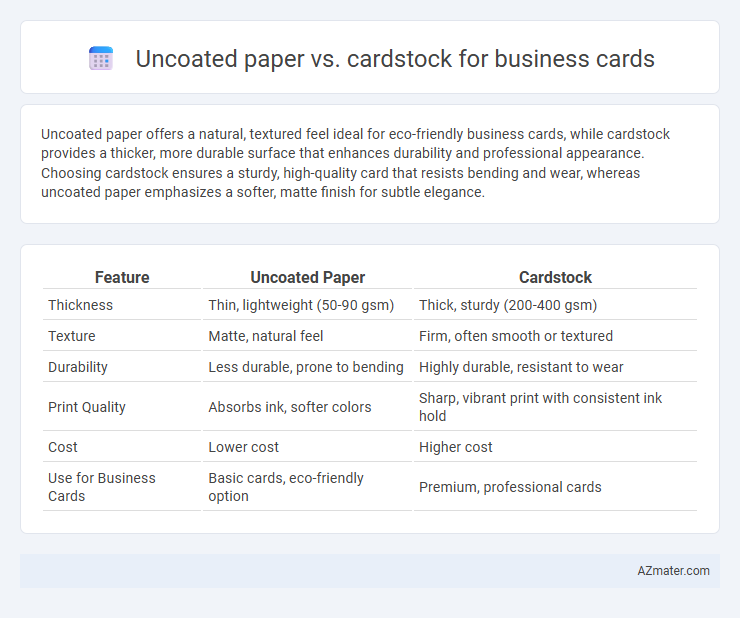Uncoated paper offers a natural, textured feel ideal for eco-friendly business cards, while cardstock provides a thicker, more durable surface that enhances durability and professional appearance. Choosing cardstock ensures a sturdy, high-quality card that resists bending and wear, whereas uncoated paper emphasizes a softer, matte finish for subtle elegance.
Table of Comparison
| Feature | Uncoated Paper | Cardstock |
|---|---|---|
| Thickness | Thin, lightweight (50-90 gsm) | Thick, sturdy (200-400 gsm) |
| Texture | Matte, natural feel | Firm, often smooth or textured |
| Durability | Less durable, prone to bending | Highly durable, resistant to wear |
| Print Quality | Absorbs ink, softer colors | Sharp, vibrant print with consistent ink hold |
| Cost | Lower cost | Higher cost |
| Use for Business Cards | Basic cards, eco-friendly option | Premium, professional cards |
Introduction: Uncoated Paper vs Cardstock for Business Cards
Uncoated paper offers a natural, textured finish that absorbs ink well, providing a classic and professional appearance for business cards. Cardstock, typically thicker and more durable, ensures enhanced sturdiness and a premium feel, making it ideal for cards meant to withstand frequent handling. Choosing between uncoated paper and cardstock depends on the desired aesthetic, durability, and tactile impression of the business card.
Understanding Uncoated Paper
Uncoated paper offers a natural, textured finish that enhances the tactile experience of business cards, making them ideal for conveying an authentic and approachable brand image. It absorbs ink more readily than coated options, resulting in less sheen but more subtle, muted colors that emphasize readability and elegance. This paper type is also environmentally friendly, often using less processing and fewer chemicals, which appeals to eco-conscious businesses seeking sustainable printing solutions.
What is Cardstock?
Cardstock is a thick, durable paper stock typically measuring between 80-110 lb cover weight, offering a sturdy and professional feel ideal for business cards. Unlike uncoated paper, cardstock provides greater rigidity, preventing easy bending and ensuring longevity in daily use. This heavyweight material also allows for vibrant ink absorption without bleeding, delivering sharp, high-quality prints for impactful business card designs.
Print Quality Comparison
Uncoated paper offers a natural, textured surface that absorbs ink differently, resulting in a softer, more muted print quality ideal for a subtle, rustic look. Cardstock, with its thicker, smoother finish, produces sharper, more vibrant colors and higher contrast, enhancing the overall professional appearance of business cards. Print durability on cardstock is superior, preventing ink smudging and offering a longer-lasting, polished finish compared to uncoated paper.
Texture and Finish Differences
Uncoated paper for business cards offers a natural, tactile texture with a matte finish that absorbs ink, providing a soft, understated look ideal for brands seeking an organic feel. Cardstock, typically thicker and more rigid, often features coated finishes such as glossy, satin, or matte, which enhance color vibrancy and provide a smoother surface that resists smudging and adds durability. The choice between uncoated and cardstock depends on the desired tactile experience and visual impact, with uncoated paper emphasizing texture and a muted aesthetic, while coated cardstock prioritizes polished finish and structural solidity.
Durability and Longevity
Uncoated paper offers a natural feel but lacks the durability and longevity of cardstock, often showing wear and fading faster under frequent handling. Cardstock, typically thicker and sturdier, provides superior resistance to bending, tearing, and moisture, ensuring business cards maintain their appearance over time. The enhanced durability of cardstock makes it the preferred choice for professional business cards that require lasting impressions.
Suitability for Design Elements
Uncoated paper offers a natural texture that enhances hand-drawn illustrations and delicate typography, providing a soft, matte finish ideal for minimalist or vintage designs. Cardstock features a thicker, sturdier surface that supports vibrant colors and embossed effects, making it suitable for bold, eye-catching business cards with strong visual impact. Both materials accommodate different design styles, with uncoated paper favoring subtle elegance and cardstock enabling more dynamic and tactile design elements.
Cost Considerations
Uncoated paper for business cards generally costs less due to its simpler production process and lower material weight, making it a budget-friendly option for large print runs. Cardstock, being thicker and more durable, involves higher manufacturing expenses, which translates into increased pricing but offers enhanced sturdiness and a premium feel. Businesses aiming to balance quality and expenditure often choose uncoated paper for cost-efficiency, while those prioritizing impression and longevity invest in cardstock despite the higher cost.
Environmental Impact
Uncoated paper for business cards offers a more eco-friendly option due to its biodegradable and recyclable properties, often produced using fewer chemicals and less energy than coated cardstock. Cardstock, while durable and premium-feeling, typically involves heavier processing and chemical coatings that reduce its recyclability and increase environmental impact. Choosing uncoated paper aligns with sustainable business practices by minimizing waste and supporting biodegradable materials in printed marketing collateral.
Choosing the Best Option for Your Brand
Uncoated paper offers a natural, tactile feel that communicates authenticity and craftsmanship, ideal for brands emphasizing eco-friendliness or a handcrafted aesthetic. Cardstock provides durability and a premium weight, making it suitable for brands seeking a strong, professional impression with enhanced rigidity. Selecting between uncoated paper and cardstock for business cards depends on your brand identity and how you want to balance texture with longevity and visual impact.

Infographic: Uncoated paper vs Cardstock for Business card
 azmater.com
azmater.com